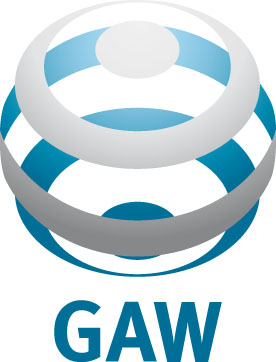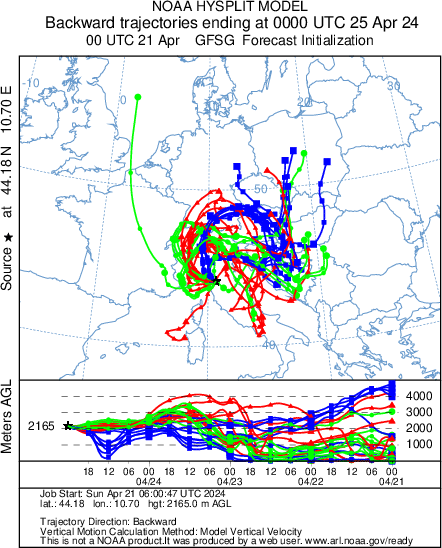History
Scientific activity history
1569 – First historically documented alpine ascent.
1655 – First measurement of the height of Mt. Cimone taken by Fathers Riccioli and Grimaldi.
1671 – Barometer was employed as altimeter by the mathematician Geminiano Montanari, "...who for the first time in Italy employed a barometer in order to measure altitudes, by using it just at Mt. Cimone..." (from "L’Appennino Modenese, descritto e illustrato, con 153 incisioni, una carta geografica e una geologica" published by Licinio Cappelli, 1895).
1816 – Military Engineers of Modena built a small pyramid on the top of the mountain for surveys of the Modena duchy’s new map.
1817 – Brioschi, Naples Observatory’s director, performing some studies on Mt. Cimone, could affirm that both the Tyrrhenian and Adriatic Sea were at the same level.
1823 – The small pyramid on the top allowed Father Inghirani to study triangulation of the Tuscan Grand Duchy.
1875 – Marquis Federico Carandini published the first guidebook on Mt. Cimone: "Una salita al Cimone".
1888 – On the top of Mt. Cimone a 14 m high octagonal section tower was built, dedicated to the memory of Geminiano Montanari and assigned to operate as Observatory-Mountain Shelter. The astronomer Pietro Tacchini, director of the Meteorological Central Observatory, built this tower, where important studies on electrical discharges, lightning rods and solar radiation were carried out. The tower was completely knocked down in the thirties. 1904 – The small church dedicated to the "Madonna of snow" was built.
1936 – The Italian Air Force Ministry built small barracks on the top for meteorological observations and flight assistance.
1937 – Inauguration of the Italian Air Force Meteorological Station: an airman by the name of Notarianni was the first operator.
1948 – The O.S.S.M.A. (Osservatorio Scientifico Sperimentale di Meteorologia Aeronautica) Air Force Experimental Scientific Meteorological Observatory was built.
1950 – Captain Fedele and Lieutenant Ottavio Vittori began to study condensation nucleuses.
1951 – Measurements to control the environmental radioactivity were performed. 1954 – Studies on thunderstorms and hail.
1959 – Studies on fog formation.
1964 – First studies on atmospheric pollution.
1978 – The system for atmospheric CO2 measurement started operating.
1979 – O.S.S.M.A. changed his name in Teleposto A.M.
Italian Climate Observatory "Ottavio Vittori" History
1939 – The ruins of the stone huts between Mt. Cimone and Mt. Cimoncino - devoted to give refuge to the excursionists - were replaced by a Shelter of Club Alpino Italiano (CAI) . On 25th of June was inaugurated the Shelter called after Gino Romualdi, an alpine officer of Modena.
1943 – The War destroyed the Shelter. 1947 – The Romualdi Shelter was rebuilt and fitted to be used again.
1949 – The Romualdi Shelter was requisitioned by the Italian Military Air Force who included it in their already existing facilities.
1981 – Ottavio Vittori, who had already been the commanding officer of the Military Air Force Mountain Centre at Mt. Cimone and subsequently director of the CNR FISBAT Institute in Bologna, now ISAC Institute, drew up a contract with the Military Air Force to use the ex-Romualdi Shelter’s first floor for scientific purposes. Measurements of atmospheric physics and chemistry were taken in a non-continuous way.
1982 – Some studies on stratospheric ozone intrusion episodes recorded at Mt. Cimone during cyclogenesis events were presented during the European Community ALPEX project (ALPine EXPeriment).
1991 – Measurements of atmospheric compounds started being continuously carried out.
1993 – DOAS (Differential Optical Absorption Spectrometry) measurements of stratospheric NO2 column amount started.
1994 - Paolo Bonasoni is appointed chief of the CNR Mt. Cimone Research Station. - The precarious conditions of the rooms at the ex-Romualdi Shelter’s first floor led to transfer the scientific instrumentation to the ground floor.
1996 - The National Research Council (CNR) renovated the assigned rooms, which since then have included the entire building of the former Romualdi Refuge; this was possible thanks to the great collaboration with the Italian Air Force and its Meteorological Service.
1996 - For the first time, the research activities carried out by the CNR in Monte Cimone become part of an international project: the two-year European Community Project VOTALP - Vertical Ozone Transport in the Alps, (Grant agreement ID: ENV4950025).
1997 - The O3, CO and meteorological parameter measures taken at the CNR station were part of the IGAC - International Global Atmospheric Chemistry project, currently operates under the umbrella of Future Earth.
1998 - The scientific activity performed at Mt. Cimone was inserted into the VOTALP II EC project (N° de convention de subvention: IC20970039 ), a follow-up project of VOTALP, already funded by the EC.
1998,15 July - The CNR’s Scientific Station at Mt. Cimone is called after Ottavio Vittori.
2000 - The scientific activity performed at Mt. Cimone was part of MINATROC - Mineral dust and tropospheric chemistry EC project. (Grant agreement ID: EVK2-CT-1999-00003).
Since the 2000s, various other projects and programs have seen the participation of the CNR with the scientific research activities carried out at the "Vittori" Climate Observatory. These research activities are reflected in the "Bibliography" session.
2004 - The "Il Sentiero dell'Atmosfera" (The Path of the Atmosphere) at Monte Cimone was created. Thanks to an idea of the CNR-ISAC, shared with the Italian Air Force Meteorological Service, the Parco del Frignano (now Parks of Central Emilia) and ARPAE, the "Il Sentiero dell'Atmosfera" was created: it is an environmental didactic itinerary for schools, students and tourists.
2011 - The World Meteorological Organization, based in Geneva, has welcomed the request, received by the Meteorological Service of the Air Force (AM) in coordination with the National Research Council (Cnr), because the research infrastructure located on the summit of Monte Cimone becomes a Global Station within the international GAW - Global Atmosphere Watch program (www.wmo.int/gaw).



